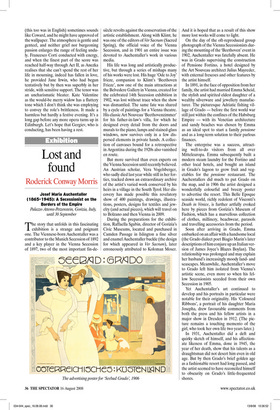Exhibition
Lost and found
Roderick Conway Morris
Josef Maria Auchentaller (1865-1945): A Secessionist on the Borders of the Empire
Palazzo Attems-Petzenstein, Gorizia, Italy, until 30 September The story that unfolds in this fascinating exhibition is a strange and poignant one. The Viennese-born Auchentaller was a contributor to the Munich Secession of 1892 and a key player in the Vienna Secession of 1897, two of the most important fin-de siècle revolts against the conservatism of the artistic establishment. Along with Klimt, he was one of the editors of Ver Sacrum (Sacred Spring), the official voice of the Vienna Secession, and in 1901 an entire issue was devoted to Auchentaller’s work in various media.
His life was long and artistically productive, but through a series of mishaps many of his works were lost. His huge ‘Ode to Joy’ frieze, companion to Klimt’s ‘Beethoven Frieze’, now one of the main attractions at the Belvedere Gallery in Vienna, created for the celebrated 14th Secession exhibition in 1902, was lost without trace when the show was dismantled. The same fate was shared by a cycle of paintings for a Vienna theatre. His classic Art Nouveau ‘Beethovenzimmer’ for his father-in-law’s villa, for which he designed every detail from the doors and murals to the piano, lamps and stained-glass windows, now survives only in a few dispersed elements in private hands. A collection of canvases bound for a retrospective in Argentina during the 1920s also vanished en route.
But more survived than even experts on the Vienna Secession until recently believed. An Austrian scholar, Vera Vogelsberger, who sadly died last year while still in her forties, tracked down an extraordinary archive of the artist’s varied work conserved by his heirs in a village in the South Tyrol. Her discovery has made possible this revelatory show of 400 paintings, drawings, illustrations, posters, designs for textiles and jewelry (and actual pieces), which will travel on to Bolzano and then Vienna in 2009.
During the preparations for the exhibition, Raffaella Sgubin, director of Gorizia’s Civic Museums, located and purchased in Camden Passage in Islington a fine silver and enamel Auchentaller buckle (the design for which appeared in Ver Sacrum), later erroneously attributed to Koloman Moser. And it is hoped that as a result of this show more lost works will come to light.
On the day of the oft-reproduced group photograph of the Vienna Secessionists during the mounting of the ‘Beethoven’ event in 1902, Auchentaller was fatefully absent. He was in Grado supervising the construction of Pensione Fortino, a hotel designed by the Art Nouveau architect Julius Mayreder, with external frescoes and other features by the artist himself.
In 1891, in the face of opposition from her family, the artist had married Emma Scheid, the stylish and spirited eldest daughter of a wealthy silverware and jewellery manufacturer. The picturesque Adriatic fishing village of Grado — before the first world war still just within the confines of the Habsburg Empire — with its Venetian architecture and sandy beaches was chosen by Emma as an ideal spot to start a family pensione and as a long-term solution to their parlous finances.
The enterprise was a success, attracting well-to-do visitors from all over Mitteleuropa. Emma subsequently built a modern steam laundry for the Fortino and other local hotels, and bought an island in Grado’s lagoon to grow fruit and vegetables for the pensione restaurant. The Auchentallers did much to put Grado on the map, and in 1906 the artist designed a wonderfully colourful and breezy poster to advertise the resort. This Belle Epoque seaside world, richly redolent of Visconti’s Death in Venice, is further artfully evoked here by pieces from Gorizia’s Museum of Fashion, which has a marvellous collection of clothes, millinery, beachwear, parasols and travelling accessories from the period.
Soon after arriving in Grado, Emma embarked on an affair with a handsome local (the Grado dialect poet Biagio Marin’s later descriptions of him conjure up an Italian version of James Joyce’s Blazes Boylan). The relationship was prolonged and may explain her husband’s increasingly moody landand seascapes. Meanwhile, Auchentaller’s move to Grado left him isolated from Vienna’s artistic scene, even more so when his fellow Secessionists seceded from their own Secession in 1905.
Yet Auchentaller’s art continued to develop and his portraits in particular were notable for their originality. His ‘Coloured Ribbons’, a portrait of his daughter Maria Josepha, drew favourable comments from both the press and his fellow artists in a major show in Dresden in 1912. (The picture remains a touching memento of the girl, who took her own life two years later.) In 1931, Auchentaller did a deft and quirky sketch of himself, and his affectionate likeness of Emma, done in 1945, the year of her death, show that his talents as a draughtsman did not desert him even in old age. But by then Grado’s brief golden age as a fashionable resort had long passed, and the artist seemed to have reconciled himself to obscurity on Grado’s little-frequented shores.


























































 Previous page
Previous page